Strategic Change Management Report: Emirates Group Analysis
VerifiedAdded on 2022/11/14
|32
|7515
|3
Report
AI Summary
This report provides a detailed analysis of strategic change management, focusing on the Emirates Group as a case study. It begins with an executive summary and introduction to change management, emphasizing the importance of adapting to the dynamic business environment. The report then delves into various change management models, including Lewin's and Deming's PDCA cycle, evaluating their relevance to organizations. It examines the significance of strategic change for Emirates, identifies factors driving the need for change, and assesses the resource implications of not responding to change. Furthermore, the report explores systems for stakeholder involvement, change management strategies, and methods for managing resistance. Finally, it recommends appropriate change models, outlines implementation steps, and suggests measures for monitoring progress, culminating in conclusions and recommendations for the Emirates Group to ensure successful operations.
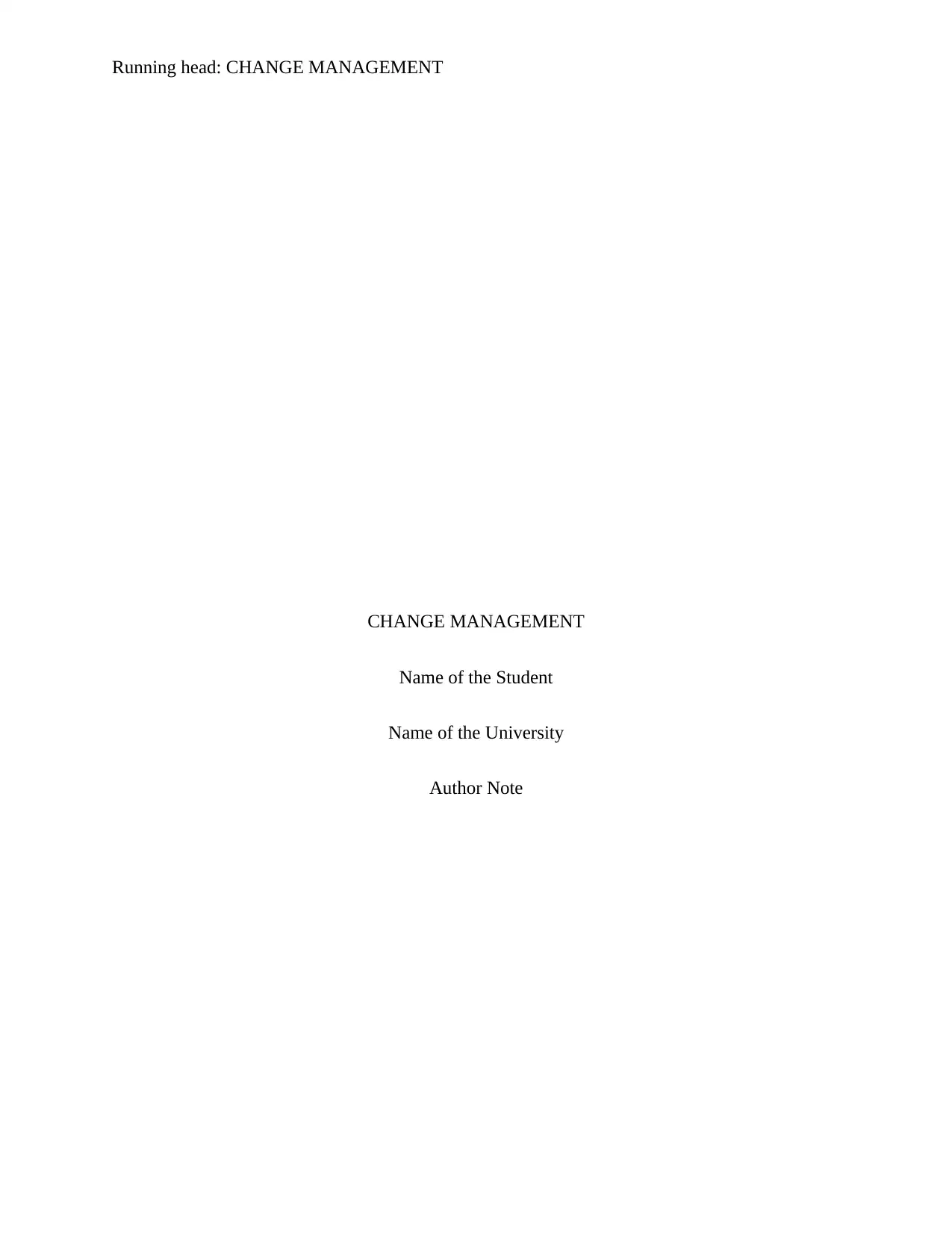
Running head: CHANGE MANAGEMENT
CHANGE MANAGEMENT
Name of the Student
Name of the University
Author Note
CHANGE MANAGEMENT
Name of the Student
Name of the University
Author Note
Paraphrase This Document
Need a fresh take? Get an instant paraphrase of this document with our AI Paraphraser
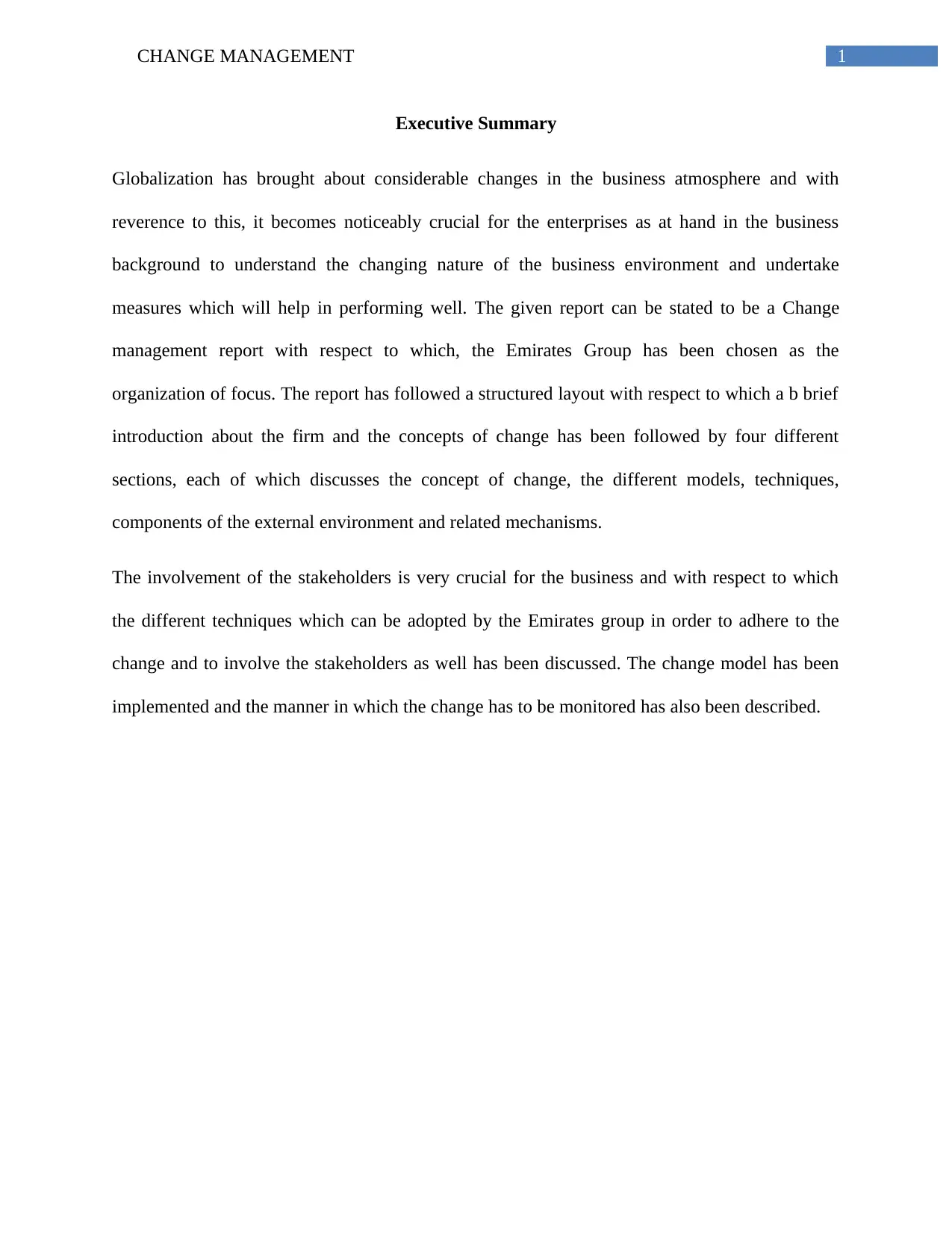
1CHANGE MANAGEMENT
Executive Summary
Globalization has brought about considerable changes in the business atmosphere and with
reverence to this, it becomes noticeably crucial for the enterprises as at hand in the business
background to understand the changing nature of the business environment and undertake
measures which will help in performing well. The given report can be stated to be a Change
management report with respect to which, the Emirates Group has been chosen as the
organization of focus. The report has followed a structured layout with respect to which a b brief
introduction about the firm and the concepts of change has been followed by four different
sections, each of which discusses the concept of change, the different models, techniques,
components of the external environment and related mechanisms.
The involvement of the stakeholders is very crucial for the business and with respect to which
the different techniques which can be adopted by the Emirates group in order to adhere to the
change and to involve the stakeholders as well has been discussed. The change model has been
implemented and the manner in which the change has to be monitored has also been described.
Executive Summary
Globalization has brought about considerable changes in the business atmosphere and with
reverence to this, it becomes noticeably crucial for the enterprises as at hand in the business
background to understand the changing nature of the business environment and undertake
measures which will help in performing well. The given report can be stated to be a Change
management report with respect to which, the Emirates Group has been chosen as the
organization of focus. The report has followed a structured layout with respect to which a b brief
introduction about the firm and the concepts of change has been followed by four different
sections, each of which discusses the concept of change, the different models, techniques,
components of the external environment and related mechanisms.
The involvement of the stakeholders is very crucial for the business and with respect to which
the different techniques which can be adopted by the Emirates group in order to adhere to the
change and to involve the stakeholders as well has been discussed. The change model has been
implemented and the manner in which the change has to be monitored has also been described.
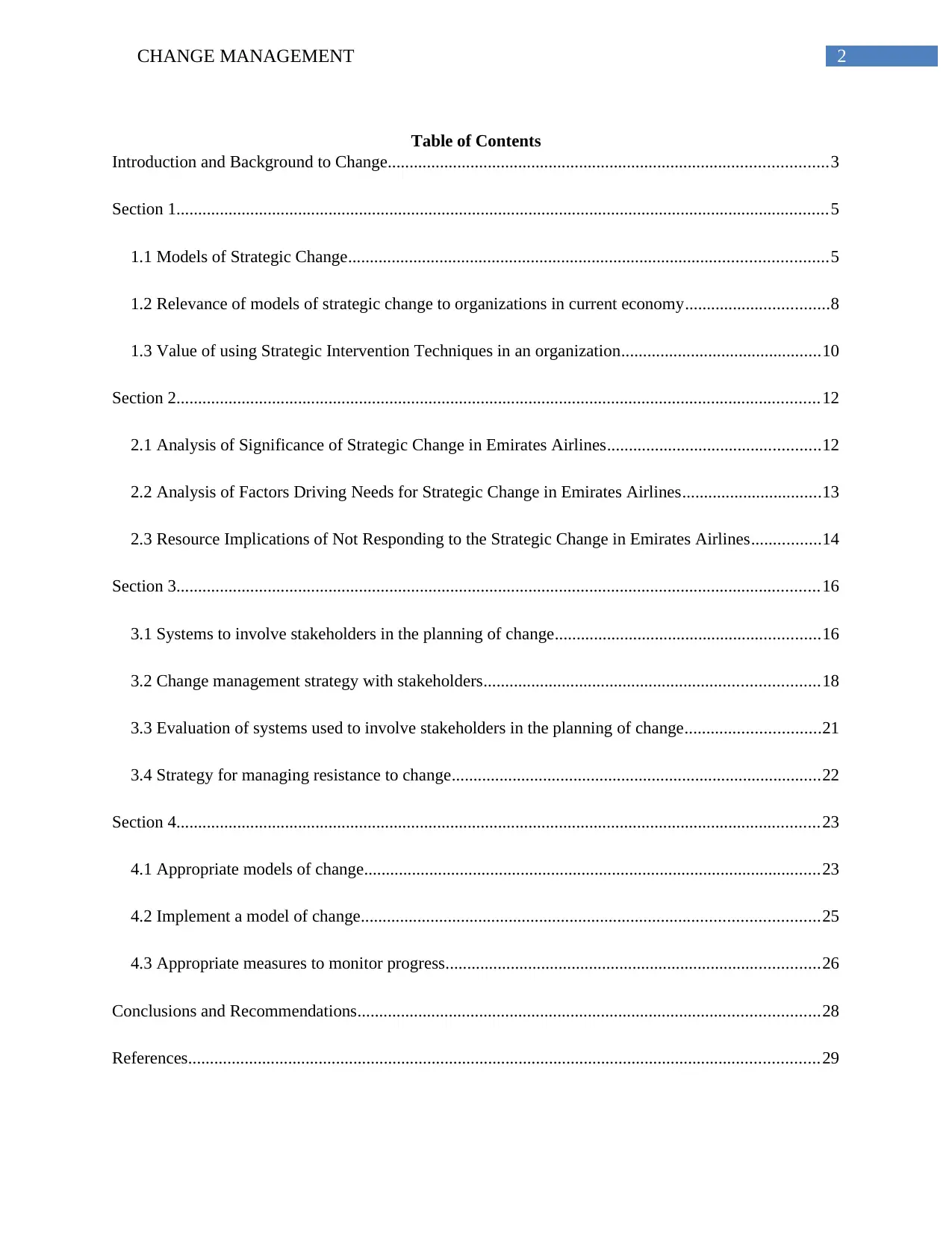
2CHANGE MANAGEMENT
Table of Contents
Introduction and Background to Change.....................................................................................................3
Section 1......................................................................................................................................................5
1.1 Models of Strategic Change..............................................................................................................5
1.2 Relevance of models of strategic change to organizations in current economy.................................8
1.3 Value of using Strategic Intervention Techniques in an organization..............................................10
Section 2....................................................................................................................................................12
2.1 Analysis of Significance of Strategic Change in Emirates Airlines.................................................12
2.2 Analysis of Factors Driving Needs for Strategic Change in Emirates Airlines................................13
2.3 Resource Implications of Not Responding to the Strategic Change in Emirates Airlines................14
Section 3....................................................................................................................................................16
3.1 Systems to involve stakeholders in the planning of change.............................................................16
3.2 Change management strategy with stakeholders.............................................................................18
3.3 Evaluation of systems used to involve stakeholders in the planning of change...............................21
3.4 Strategy for managing resistance to change.....................................................................................22
Section 4....................................................................................................................................................23
4.1 Appropriate models of change.........................................................................................................23
4.2 Implement a model of change.........................................................................................................25
4.3 Appropriate measures to monitor progress......................................................................................26
Conclusions and Recommendations..........................................................................................................28
References.................................................................................................................................................29
Table of Contents
Introduction and Background to Change.....................................................................................................3
Section 1......................................................................................................................................................5
1.1 Models of Strategic Change..............................................................................................................5
1.2 Relevance of models of strategic change to organizations in current economy.................................8
1.3 Value of using Strategic Intervention Techniques in an organization..............................................10
Section 2....................................................................................................................................................12
2.1 Analysis of Significance of Strategic Change in Emirates Airlines.................................................12
2.2 Analysis of Factors Driving Needs for Strategic Change in Emirates Airlines................................13
2.3 Resource Implications of Not Responding to the Strategic Change in Emirates Airlines................14
Section 3....................................................................................................................................................16
3.1 Systems to involve stakeholders in the planning of change.............................................................16
3.2 Change management strategy with stakeholders.............................................................................18
3.3 Evaluation of systems used to involve stakeholders in the planning of change...............................21
3.4 Strategy for managing resistance to change.....................................................................................22
Section 4....................................................................................................................................................23
4.1 Appropriate models of change.........................................................................................................23
4.2 Implement a model of change.........................................................................................................25
4.3 Appropriate measures to monitor progress......................................................................................26
Conclusions and Recommendations..........................................................................................................28
References.................................................................................................................................................29
⊘ This is a preview!⊘
Do you want full access?
Subscribe today to unlock all pages.

Trusted by 1+ million students worldwide
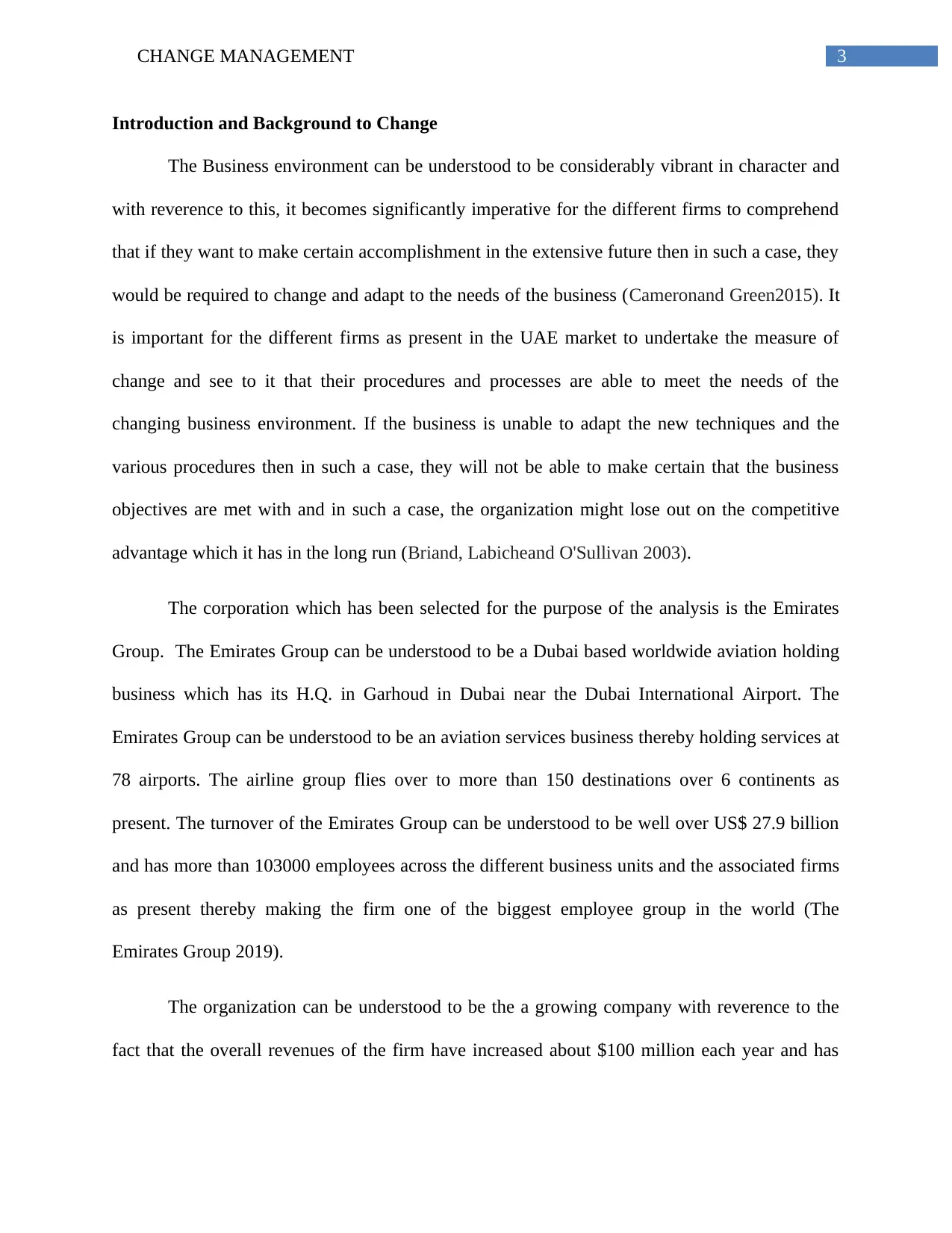
3CHANGE MANAGEMENT
Introduction and Background to Change
The Business environment can be understood to be considerably vibrant in character and
with reverence to this, it becomes significantly imperative for the different firms to comprehend
that if they want to make certain accomplishment in the extensive future then in such a case, they
would be required to change and adapt to the needs of the business (Cameronand Green2015). It
is important for the different firms as present in the UAE market to undertake the measure of
change and see to it that their procedures and processes are able to meet the needs of the
changing business environment. If the business is unable to adapt the new techniques and the
various procedures then in such a case, they will not be able to make certain that the business
objectives are met with and in such a case, the organization might lose out on the competitive
advantage which it has in the long run (Briand, Labicheand O'Sullivan 2003).
The corporation which has been selected for the purpose of the analysis is the Emirates
Group. The Emirates Group can be understood to be a Dubai based worldwide aviation holding
business which has its H.Q. in Garhoud in Dubai near the Dubai International Airport. The
Emirates Group can be understood to be an aviation services business thereby holding services at
78 airports. The airline group flies over to more than 150 destinations over 6 continents as
present. The turnover of the Emirates Group can be understood to be well over US$ 27.9 billion
and has more than 103000 employees across the different business units and the associated firms
as present thereby making the firm one of the biggest employee group in the world (The
Emirates Group 2019).
The organization can be understood to be the a growing company with reverence to the
fact that the overall revenues of the firm have increased about $100 million each year and has
Introduction and Background to Change
The Business environment can be understood to be considerably vibrant in character and
with reverence to this, it becomes significantly imperative for the different firms to comprehend
that if they want to make certain accomplishment in the extensive future then in such a case, they
would be required to change and adapt to the needs of the business (Cameronand Green2015). It
is important for the different firms as present in the UAE market to undertake the measure of
change and see to it that their procedures and processes are able to meet the needs of the
changing business environment. If the business is unable to adapt the new techniques and the
various procedures then in such a case, they will not be able to make certain that the business
objectives are met with and in such a case, the organization might lose out on the competitive
advantage which it has in the long run (Briand, Labicheand O'Sullivan 2003).
The corporation which has been selected for the purpose of the analysis is the Emirates
Group. The Emirates Group can be understood to be a Dubai based worldwide aviation holding
business which has its H.Q. in Garhoud in Dubai near the Dubai International Airport. The
Emirates Group can be understood to be an aviation services business thereby holding services at
78 airports. The airline group flies over to more than 150 destinations over 6 continents as
present. The turnover of the Emirates Group can be understood to be well over US$ 27.9 billion
and has more than 103000 employees across the different business units and the associated firms
as present thereby making the firm one of the biggest employee group in the world (The
Emirates Group 2019).
The organization can be understood to be the a growing company with reverence to the
fact that the overall revenues of the firm have increased about $100 million each year and has
Paraphrase This Document
Need a fresh take? Get an instant paraphrase of this document with our AI Paraphraser
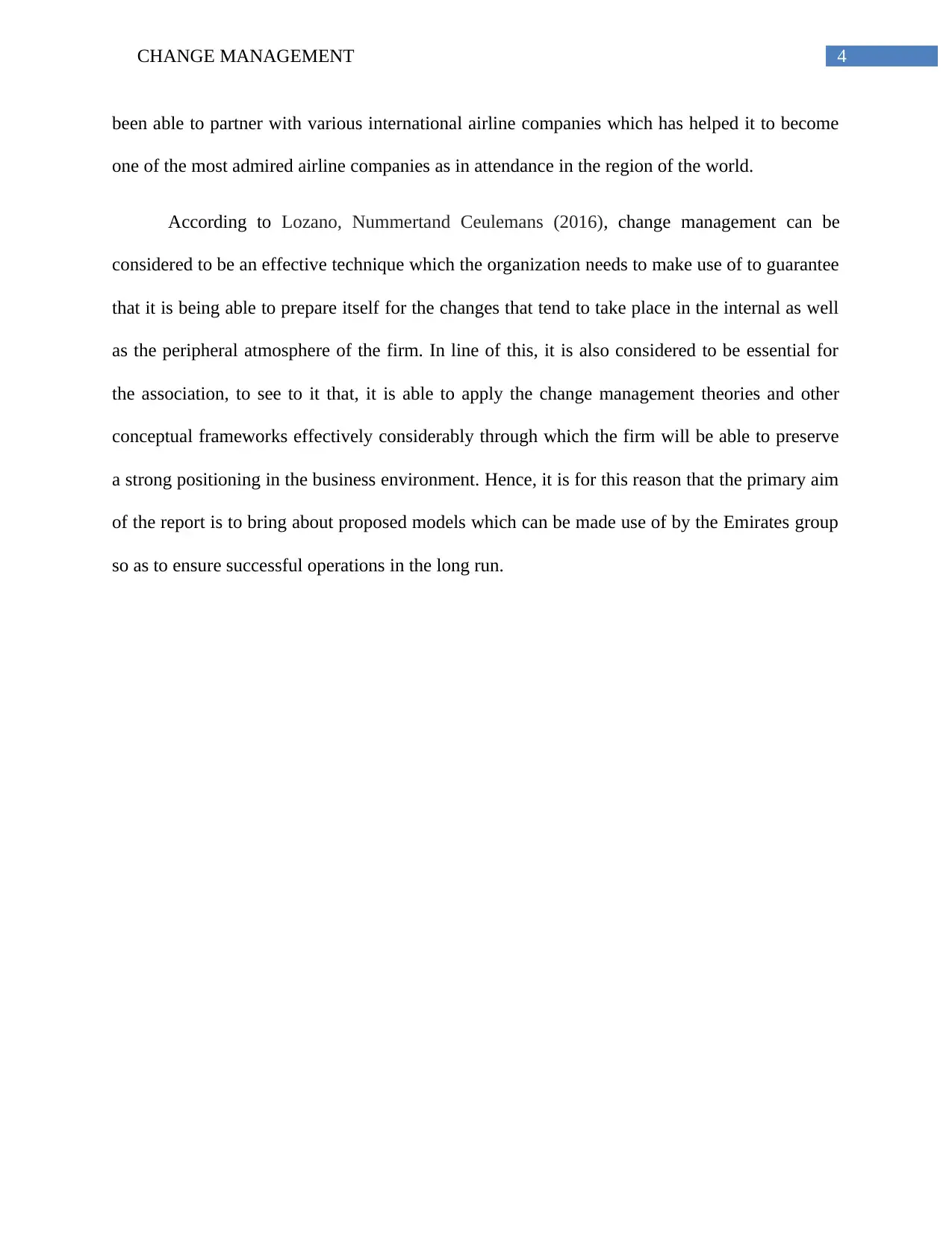
4CHANGE MANAGEMENT
been able to partner with various international airline companies which has helped it to become
one of the most admired airline companies as in attendance in the region of the world.
According to Lozano, Nummertand Ceulemans (2016), change management can be
considered to be an effective technique which the organization needs to make use of to guarantee
that it is being able to prepare itself for the changes that tend to take place in the internal as well
as the peripheral atmosphere of the firm. In line of this, it is also considered to be essential for
the association, to see to it that, it is able to apply the change management theories and other
conceptual frameworks effectively considerably through which the firm will be able to preserve
a strong positioning in the business environment. Hence, it is for this reason that the primary aim
of the report is to bring about proposed models which can be made use of by the Emirates group
so as to ensure successful operations in the long run.
been able to partner with various international airline companies which has helped it to become
one of the most admired airline companies as in attendance in the region of the world.
According to Lozano, Nummertand Ceulemans (2016), change management can be
considered to be an effective technique which the organization needs to make use of to guarantee
that it is being able to prepare itself for the changes that tend to take place in the internal as well
as the peripheral atmosphere of the firm. In line of this, it is also considered to be essential for
the association, to see to it that, it is able to apply the change management theories and other
conceptual frameworks effectively considerably through which the firm will be able to preserve
a strong positioning in the business environment. Hence, it is for this reason that the primary aim
of the report is to bring about proposed models which can be made use of by the Emirates group
so as to ensure successful operations in the long run.
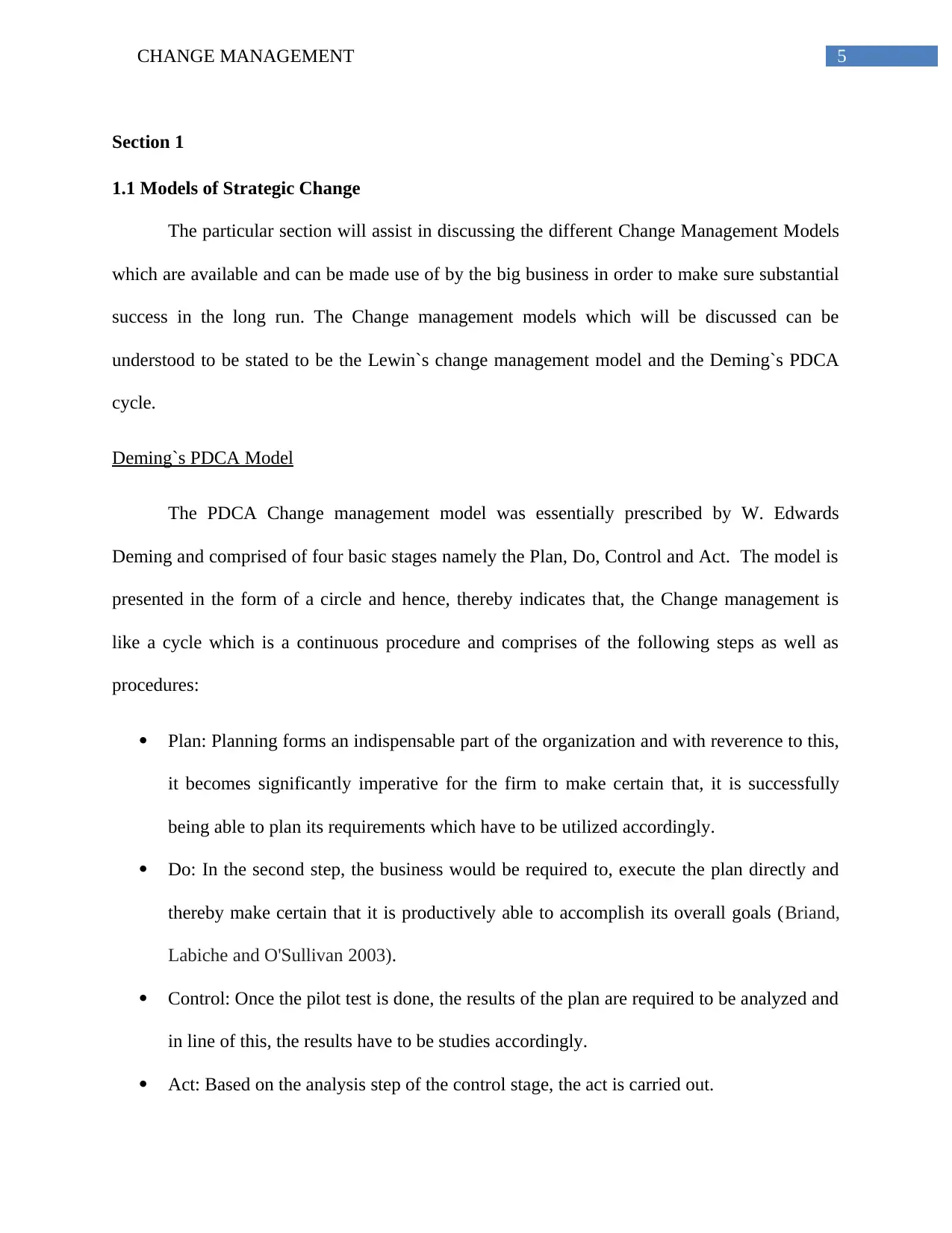
5CHANGE MANAGEMENT
Section 1
1.1 Models of Strategic Change
The particular section will assist in discussing the different Change Management Models
which are available and can be made use of by the big business in order to make sure substantial
success in the long run. The Change management models which will be discussed can be
understood to be stated to be the Lewin`s change management model and the Deming`s PDCA
cycle.
Deming`s PDCA Model
The PDCA Change management model was essentially prescribed by W. Edwards
Deming and comprised of four basic stages namely the Plan, Do, Control and Act. The model is
presented in the form of a circle and hence, thereby indicates that, the Change management is
like a cycle which is a continuous procedure and comprises of the following steps as well as
procedures:
Plan: Planning forms an indispensable part of the organization and with reverence to this,
it becomes significantly imperative for the firm to make certain that, it is successfully
being able to plan its requirements which have to be utilized accordingly.
Do: In the second step, the business would be required to, execute the plan directly and
thereby make certain that it is productively able to accomplish its overall goals (Briand,
Labiche and O'Sullivan 2003).
Control: Once the pilot test is done, the results of the plan are required to be analyzed and
in line of this, the results have to be studies accordingly.
Act: Based on the analysis step of the control stage, the act is carried out.
Section 1
1.1 Models of Strategic Change
The particular section will assist in discussing the different Change Management Models
which are available and can be made use of by the big business in order to make sure substantial
success in the long run. The Change management models which will be discussed can be
understood to be stated to be the Lewin`s change management model and the Deming`s PDCA
cycle.
Deming`s PDCA Model
The PDCA Change management model was essentially prescribed by W. Edwards
Deming and comprised of four basic stages namely the Plan, Do, Control and Act. The model is
presented in the form of a circle and hence, thereby indicates that, the Change management is
like a cycle which is a continuous procedure and comprises of the following steps as well as
procedures:
Plan: Planning forms an indispensable part of the organization and with reverence to this,
it becomes significantly imperative for the firm to make certain that, it is successfully
being able to plan its requirements which have to be utilized accordingly.
Do: In the second step, the business would be required to, execute the plan directly and
thereby make certain that it is productively able to accomplish its overall goals (Briand,
Labiche and O'Sullivan 2003).
Control: Once the pilot test is done, the results of the plan are required to be analyzed and
in line of this, the results have to be studies accordingly.
Act: Based on the analysis step of the control stage, the act is carried out.
⊘ This is a preview!⊘
Do you want full access?
Subscribe today to unlock all pages.

Trusted by 1+ million students worldwide
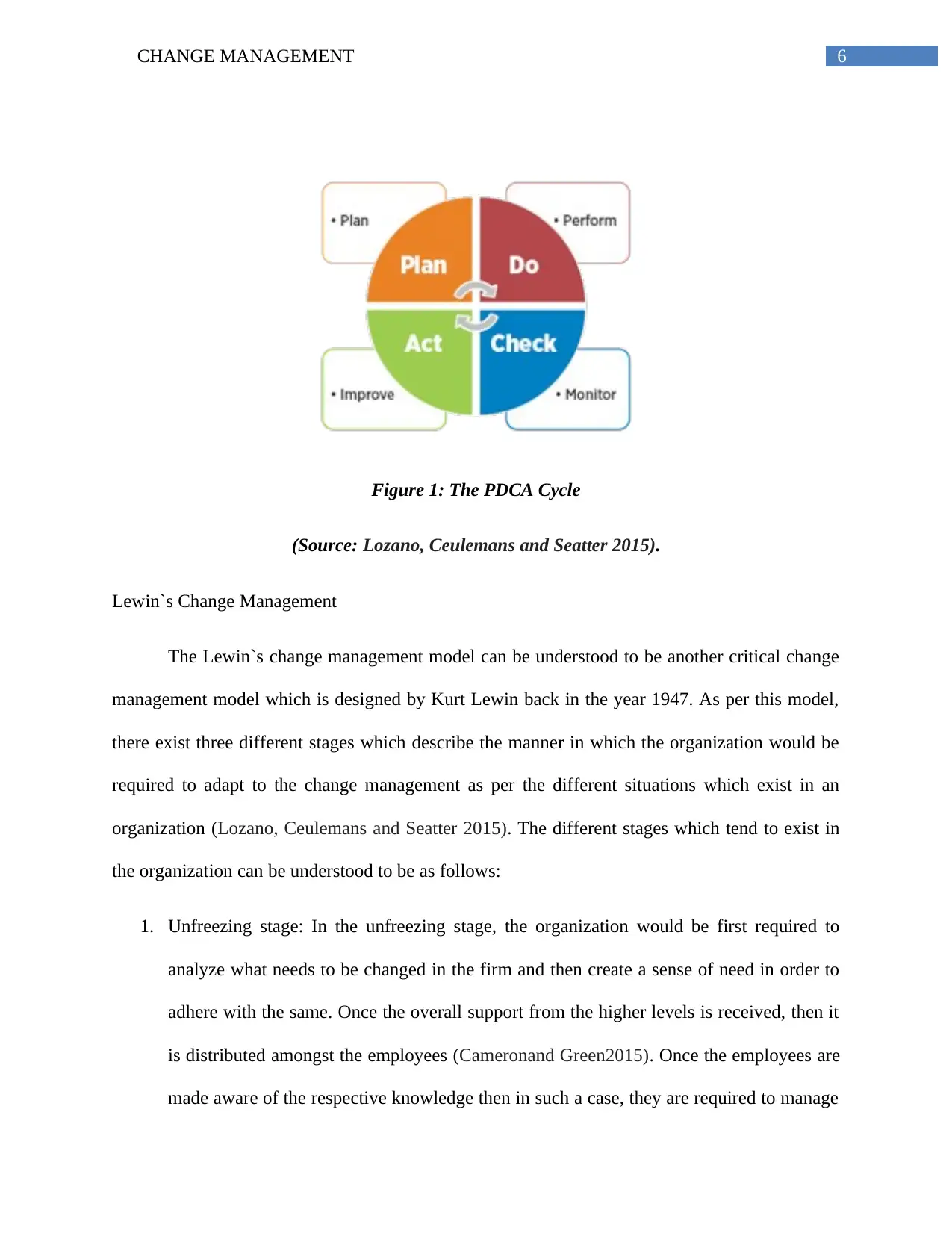
6CHANGE MANAGEMENT
Figure 1: The PDCA Cycle
(Source: Lozano, Ceulemans and Seatter 2015).
Lewin`s Change Management
The Lewin`s change management model can be understood to be another critical change
management model which is designed by Kurt Lewin back in the year 1947. As per this model,
there exist three different stages which describe the manner in which the organization would be
required to adapt to the change management as per the different situations which exist in an
organization (Lozano, Ceulemans and Seatter 2015). The different stages which tend to exist in
the organization can be understood to be as follows:
1. Unfreezing stage: In the unfreezing stage, the organization would be first required to
analyze what needs to be changed in the firm and then create a sense of need in order to
adhere with the same. Once the overall support from the higher levels is received, then it
is distributed amongst the employees (Cameronand Green2015). Once the employees are
made aware of the respective knowledge then in such a case, they are required to manage
Figure 1: The PDCA Cycle
(Source: Lozano, Ceulemans and Seatter 2015).
Lewin`s Change Management
The Lewin`s change management model can be understood to be another critical change
management model which is designed by Kurt Lewin back in the year 1947. As per this model,
there exist three different stages which describe the manner in which the organization would be
required to adapt to the change management as per the different situations which exist in an
organization (Lozano, Ceulemans and Seatter 2015). The different stages which tend to exist in
the organization can be understood to be as follows:
1. Unfreezing stage: In the unfreezing stage, the organization would be first required to
analyze what needs to be changed in the firm and then create a sense of need in order to
adhere with the same. Once the overall support from the higher levels is received, then it
is distributed amongst the employees (Cameronand Green2015). Once the employees are
made aware of the respective knowledge then in such a case, they are required to manage
Paraphrase This Document
Need a fresh take? Get an instant paraphrase of this document with our AI Paraphraser
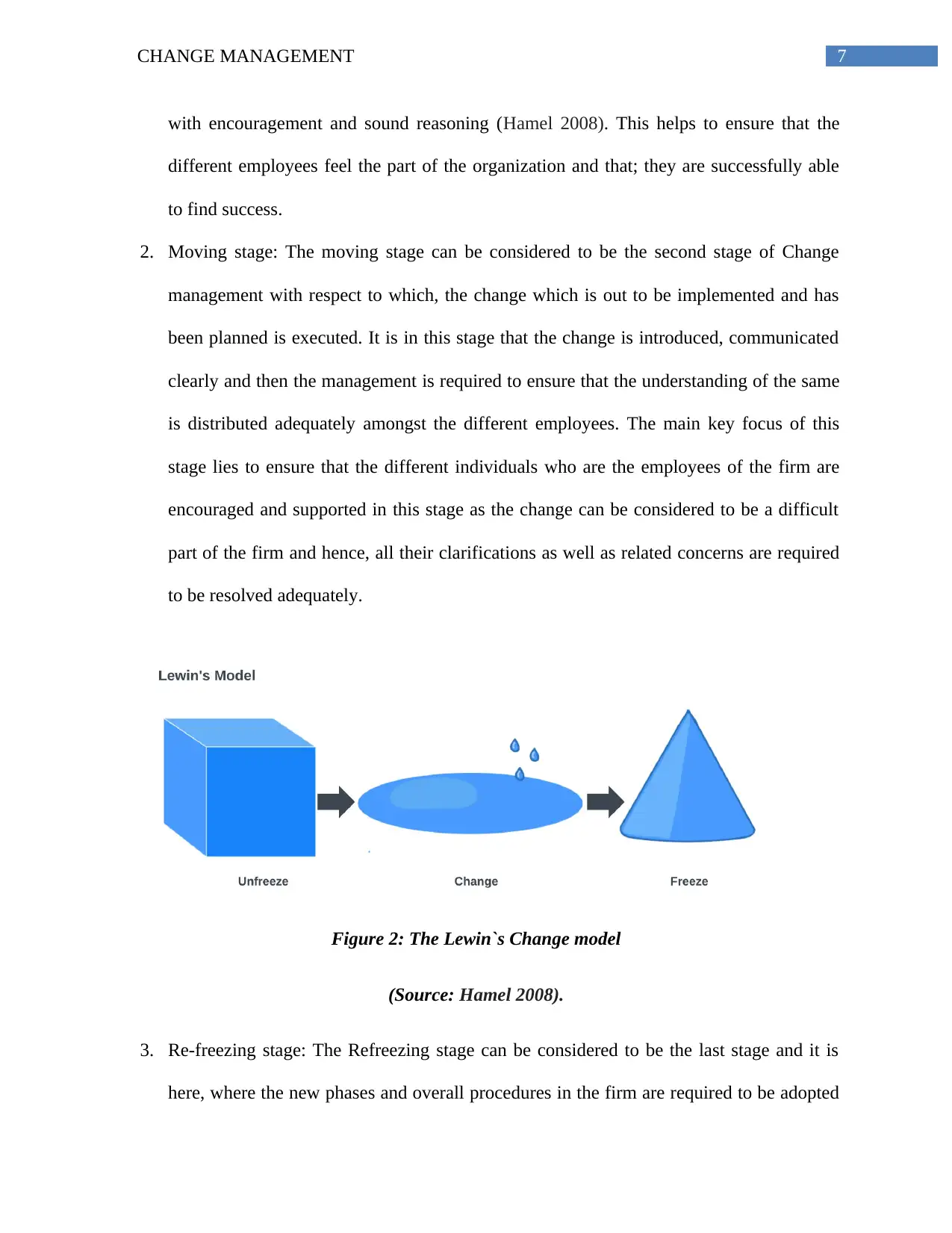
7CHANGE MANAGEMENT
with encouragement and sound reasoning (Hamel 2008). This helps to ensure that the
different employees feel the part of the organization and that; they are successfully able
to find success.
2. Moving stage: The moving stage can be considered to be the second stage of Change
management with respect to which, the change which is out to be implemented and has
been planned is executed. It is in this stage that the change is introduced, communicated
clearly and then the management is required to ensure that the understanding of the same
is distributed adequately amongst the different employees. The main key focus of this
stage lies to ensure that the different individuals who are the employees of the firm are
encouraged and supported in this stage as the change can be considered to be a difficult
part of the firm and hence, all their clarifications as well as related concerns are required
to be resolved adequately.
Figure 2: The Lewin`s Change model
(Source: Hamel 2008).
3. Re-freezing stage: The Refreezing stage can be considered to be the last stage and it is
here, where the new phases and overall procedures in the firm are required to be adopted
with encouragement and sound reasoning (Hamel 2008). This helps to ensure that the
different employees feel the part of the organization and that; they are successfully able
to find success.
2. Moving stage: The moving stage can be considered to be the second stage of Change
management with respect to which, the change which is out to be implemented and has
been planned is executed. It is in this stage that the change is introduced, communicated
clearly and then the management is required to ensure that the understanding of the same
is distributed adequately amongst the different employees. The main key focus of this
stage lies to ensure that the different individuals who are the employees of the firm are
encouraged and supported in this stage as the change can be considered to be a difficult
part of the firm and hence, all their clarifications as well as related concerns are required
to be resolved adequately.
Figure 2: The Lewin`s Change model
(Source: Hamel 2008).
3. Re-freezing stage: The Refreezing stage can be considered to be the last stage and it is
here, where the new phases and overall procedures in the firm are required to be adopted
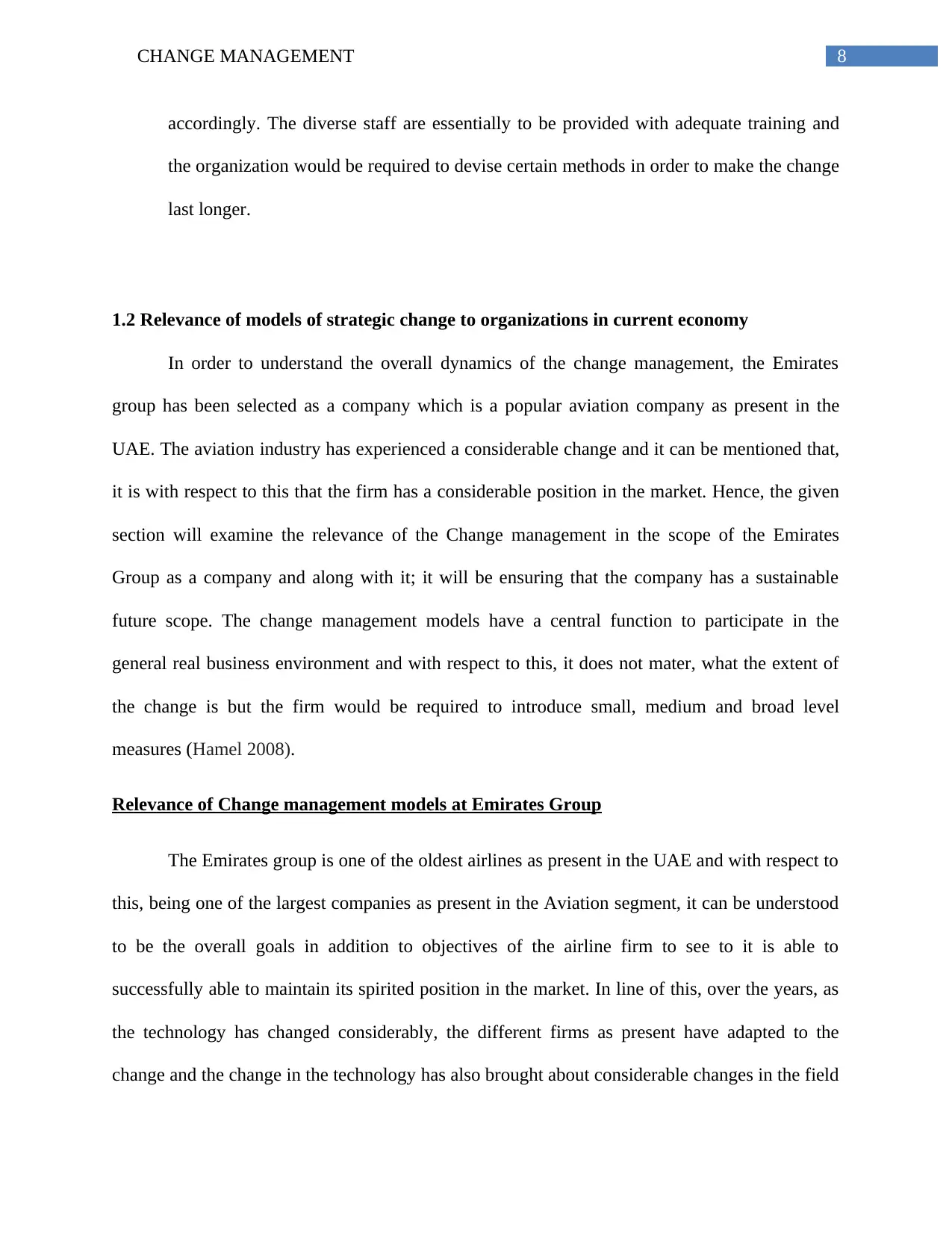
8CHANGE MANAGEMENT
accordingly. The diverse staff are essentially to be provided with adequate training and
the organization would be required to devise certain methods in order to make the change
last longer.
1.2 Relevance of models of strategic change to organizations in current economy
In order to understand the overall dynamics of the change management, the Emirates
group has been selected as a company which is a popular aviation company as present in the
UAE. The aviation industry has experienced a considerable change and it can be mentioned that,
it is with respect to this that the firm has a considerable position in the market. Hence, the given
section will examine the relevance of the Change management in the scope of the Emirates
Group as a company and along with it; it will be ensuring that the company has a sustainable
future scope. The change management models have a central function to participate in the
general real business environment and with respect to this, it does not mater, what the extent of
the change is but the firm would be required to introduce small, medium and broad level
measures (Hamel 2008).
Relevance of Change management models at Emirates Group
The Emirates group is one of the oldest airlines as present in the UAE and with respect to
this, being one of the largest companies as present in the Aviation segment, it can be understood
to be the overall goals in addition to objectives of the airline firm to see to it is able to
successfully able to maintain its spirited position in the market. In line of this, over the years, as
the technology has changed considerably, the different firms as present have adapted to the
change and the change in the technology has also brought about considerable changes in the field
accordingly. The diverse staff are essentially to be provided with adequate training and
the organization would be required to devise certain methods in order to make the change
last longer.
1.2 Relevance of models of strategic change to organizations in current economy
In order to understand the overall dynamics of the change management, the Emirates
group has been selected as a company which is a popular aviation company as present in the
UAE. The aviation industry has experienced a considerable change and it can be mentioned that,
it is with respect to this that the firm has a considerable position in the market. Hence, the given
section will examine the relevance of the Change management in the scope of the Emirates
Group as a company and along with it; it will be ensuring that the company has a sustainable
future scope. The change management models have a central function to participate in the
general real business environment and with respect to this, it does not mater, what the extent of
the change is but the firm would be required to introduce small, medium and broad level
measures (Hamel 2008).
Relevance of Change management models at Emirates Group
The Emirates group is one of the oldest airlines as present in the UAE and with respect to
this, being one of the largest companies as present in the Aviation segment, it can be understood
to be the overall goals in addition to objectives of the airline firm to see to it is able to
successfully able to maintain its spirited position in the market. In line of this, over the years, as
the technology has changed considerably, the different firms as present have adapted to the
change and the change in the technology has also brought about considerable changes in the field
⊘ This is a preview!⊘
Do you want full access?
Subscribe today to unlock all pages.

Trusted by 1+ million students worldwide
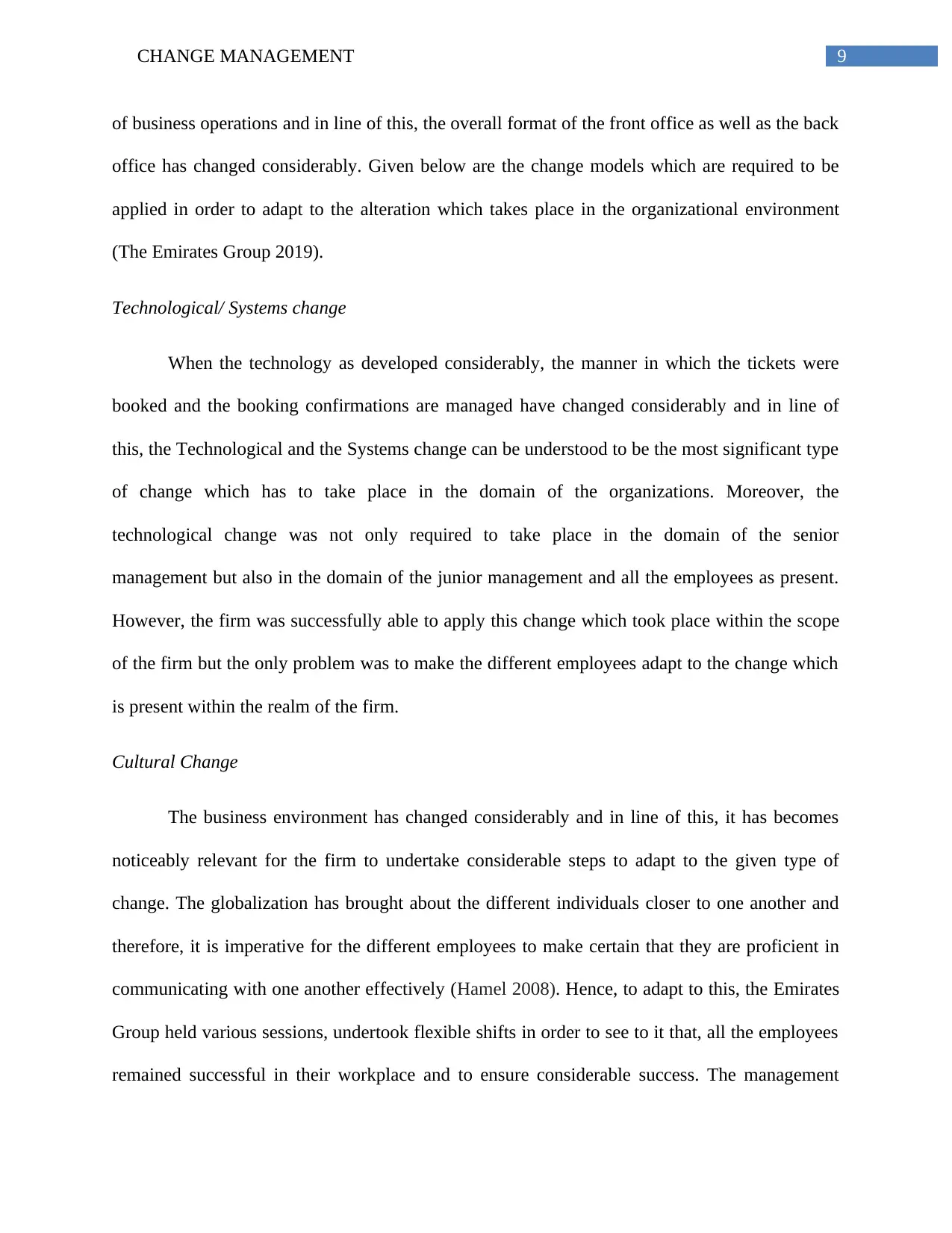
9CHANGE MANAGEMENT
of business operations and in line of this, the overall format of the front office as well as the back
office has changed considerably. Given below are the change models which are required to be
applied in order to adapt to the alteration which takes place in the organizational environment
(The Emirates Group 2019).
Technological/ Systems change
When the technology as developed considerably, the manner in which the tickets were
booked and the booking confirmations are managed have changed considerably and in line of
this, the Technological and the Systems change can be understood to be the most significant type
of change which has to take place in the domain of the organizations. Moreover, the
technological change was not only required to take place in the domain of the senior
management but also in the domain of the junior management and all the employees as present.
However, the firm was successfully able to apply this change which took place within the scope
of the firm but the only problem was to make the different employees adapt to the change which
is present within the realm of the firm.
Cultural Change
The business environment has changed considerably and in line of this, it has becomes
noticeably relevant for the firm to undertake considerable steps to adapt to the given type of
change. The globalization has brought about the different individuals closer to one another and
therefore, it is imperative for the different employees to make certain that they are proficient in
communicating with one another effectively (Hamel 2008). Hence, to adapt to this, the Emirates
Group held various sessions, undertook flexible shifts in order to see to it that, all the employees
remained successful in their workplace and to ensure considerable success. The management
of business operations and in line of this, the overall format of the front office as well as the back
office has changed considerably. Given below are the change models which are required to be
applied in order to adapt to the alteration which takes place in the organizational environment
(The Emirates Group 2019).
Technological/ Systems change
When the technology as developed considerably, the manner in which the tickets were
booked and the booking confirmations are managed have changed considerably and in line of
this, the Technological and the Systems change can be understood to be the most significant type
of change which has to take place in the domain of the organizations. Moreover, the
technological change was not only required to take place in the domain of the senior
management but also in the domain of the junior management and all the employees as present.
However, the firm was successfully able to apply this change which took place within the scope
of the firm but the only problem was to make the different employees adapt to the change which
is present within the realm of the firm.
Cultural Change
The business environment has changed considerably and in line of this, it has becomes
noticeably relevant for the firm to undertake considerable steps to adapt to the given type of
change. The globalization has brought about the different individuals closer to one another and
therefore, it is imperative for the different employees to make certain that they are proficient in
communicating with one another effectively (Hamel 2008). Hence, to adapt to this, the Emirates
Group held various sessions, undertook flexible shifts in order to see to it that, all the employees
remained successful in their workplace and to ensure considerable success. The management
Paraphrase This Document
Need a fresh take? Get an instant paraphrase of this document with our AI Paraphraser
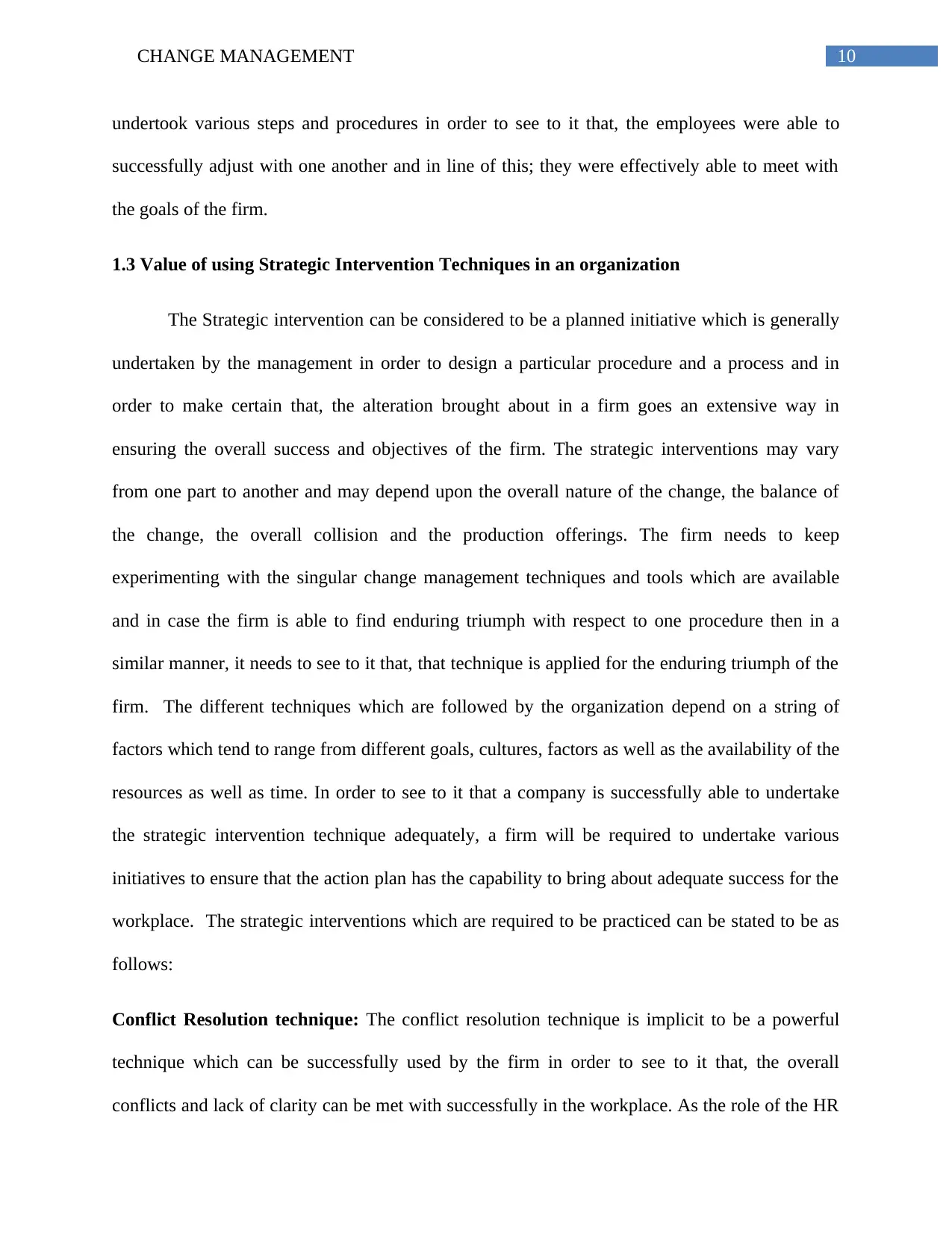
10CHANGE MANAGEMENT
undertook various steps and procedures in order to see to it that, the employees were able to
successfully adjust with one another and in line of this; they were effectively able to meet with
the goals of the firm.
1.3 Value of using Strategic Intervention Techniques in an organization
The Strategic intervention can be considered to be a planned initiative which is generally
undertaken by the management in order to design a particular procedure and a process and in
order to make certain that, the alteration brought about in a firm goes an extensive way in
ensuring the overall success and objectives of the firm. The strategic interventions may vary
from one part to another and may depend upon the overall nature of the change, the balance of
the change, the overall collision and the production offerings. The firm needs to keep
experimenting with the singular change management techniques and tools which are available
and in case the firm is able to find enduring triumph with respect to one procedure then in a
similar manner, it needs to see to it that, that technique is applied for the enduring triumph of the
firm. The different techniques which are followed by the organization depend on a string of
factors which tend to range from different goals, cultures, factors as well as the availability of the
resources as well as time. In order to see to it that a company is successfully able to undertake
the strategic intervention technique adequately, a firm will be required to undertake various
initiatives to ensure that the action plan has the capability to bring about adequate success for the
workplace. The strategic interventions which are required to be practiced can be stated to be as
follows:
Conflict Resolution technique: The conflict resolution technique is implicit to be a powerful
technique which can be successfully used by the firm in order to see to it that, the overall
conflicts and lack of clarity can be met with successfully in the workplace. As the role of the HR
undertook various steps and procedures in order to see to it that, the employees were able to
successfully adjust with one another and in line of this; they were effectively able to meet with
the goals of the firm.
1.3 Value of using Strategic Intervention Techniques in an organization
The Strategic intervention can be considered to be a planned initiative which is generally
undertaken by the management in order to design a particular procedure and a process and in
order to make certain that, the alteration brought about in a firm goes an extensive way in
ensuring the overall success and objectives of the firm. The strategic interventions may vary
from one part to another and may depend upon the overall nature of the change, the balance of
the change, the overall collision and the production offerings. The firm needs to keep
experimenting with the singular change management techniques and tools which are available
and in case the firm is able to find enduring triumph with respect to one procedure then in a
similar manner, it needs to see to it that, that technique is applied for the enduring triumph of the
firm. The different techniques which are followed by the organization depend on a string of
factors which tend to range from different goals, cultures, factors as well as the availability of the
resources as well as time. In order to see to it that a company is successfully able to undertake
the strategic intervention technique adequately, a firm will be required to undertake various
initiatives to ensure that the action plan has the capability to bring about adequate success for the
workplace. The strategic interventions which are required to be practiced can be stated to be as
follows:
Conflict Resolution technique: The conflict resolution technique is implicit to be a powerful
technique which can be successfully used by the firm in order to see to it that, the overall
conflicts and lack of clarity can be met with successfully in the workplace. As the role of the HR
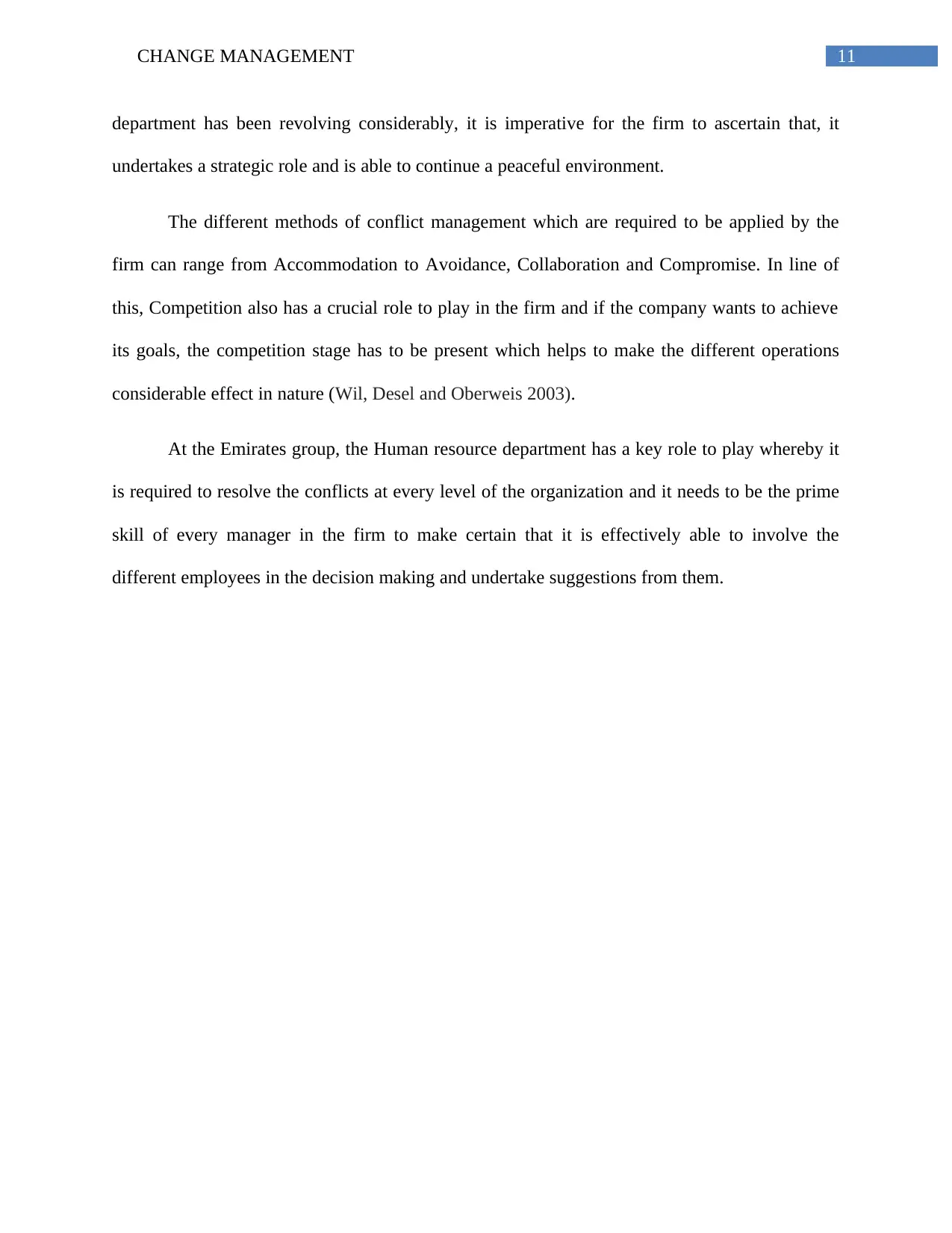
11CHANGE MANAGEMENT
department has been revolving considerably, it is imperative for the firm to ascertain that, it
undertakes a strategic role and is able to continue a peaceful environment.
The different methods of conflict management which are required to be applied by the
firm can range from Accommodation to Avoidance, Collaboration and Compromise. In line of
this, Competition also has a crucial role to play in the firm and if the company wants to achieve
its goals, the competition stage has to be present which helps to make the different operations
considerable effect in nature (Wil, Desel and Oberweis 2003).
At the Emirates group, the Human resource department has a key role to play whereby it
is required to resolve the conflicts at every level of the organization and it needs to be the prime
skill of every manager in the firm to make certain that it is effectively able to involve the
different employees in the decision making and undertake suggestions from them.
department has been revolving considerably, it is imperative for the firm to ascertain that, it
undertakes a strategic role and is able to continue a peaceful environment.
The different methods of conflict management which are required to be applied by the
firm can range from Accommodation to Avoidance, Collaboration and Compromise. In line of
this, Competition also has a crucial role to play in the firm and if the company wants to achieve
its goals, the competition stage has to be present which helps to make the different operations
considerable effect in nature (Wil, Desel and Oberweis 2003).
At the Emirates group, the Human resource department has a key role to play whereby it
is required to resolve the conflicts at every level of the organization and it needs to be the prime
skill of every manager in the firm to make certain that it is effectively able to involve the
different employees in the decision making and undertake suggestions from them.
⊘ This is a preview!⊘
Do you want full access?
Subscribe today to unlock all pages.

Trusted by 1+ million students worldwide
1 out of 32
Related Documents
Your All-in-One AI-Powered Toolkit for Academic Success.
+13062052269
info@desklib.com
Available 24*7 on WhatsApp / Email
![[object Object]](/_next/static/media/star-bottom.7253800d.svg)
Unlock your academic potential
Copyright © 2020–2025 A2Z Services. All Rights Reserved. Developed and managed by ZUCOL.





